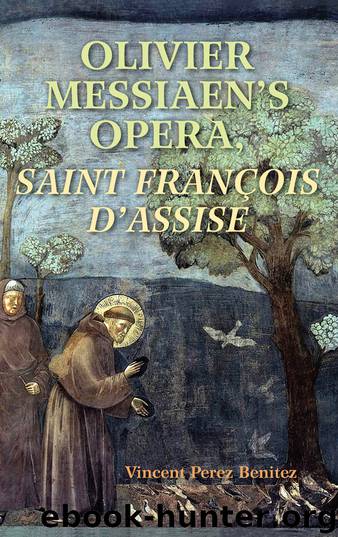Olivier Messiaen's Opera, Saint Francois D'Assise by Vincent Perez Benitez;

Author:Vincent Perez Benitez;
Language: eng
Format: epub
ISBN: 9780253042903
Publisher: Indiana University Press
Published: 2019-07-19T16:00:00+00:00
Example 5.1. Harmonic palindrome associated with Saint Francis’s primary theme, Le Baiser au Lépreux, R109:1–R110:1. Saint François d’Assise, by Olivier Messiaen. © 1983 by Éditions Musicales Alphonse Leduc, Paris. This arrangement © 2018 by Éditions Musicales Alphonse Leduc, Paris. International copyright secured. All rights reserved. Reprinted by Permission of Hal Leonard LLC.
Messiaen uses other harmonic palindromes in Saint François as independent chordal successions. Unlike example 5.1, these palindromes do not suggest clear, dramatic referential associations; rather, they function more to intensify their associated pitch contexts by giving prominence to certain chord types. In scene 2, Les Laudes (13, R13:1–4), overlapping harmonic palindromes support an interior section of the first of Saint Francis’s strophes in praise of nature. In this four-measure passage, there are seven chords (1–7). Palindrome 1 comprises chords 1 through 5 (scs6-Z47, 4-17, 4-6, 4-17, and 6-Z47), and Palindrome 2, 3 through 7 (4-6, 4-17, 6-Z47, 4-17, and 4-6). Set class 6-Z47 governs Palindrome 1 by opening (1) and closing it (5), and, in like manner, 4-6 governs Palindrome 2 by occupying its first and last positions (3 and 7). These scs likewise serve as the opposite palindrome’s central sonority (3 and 5). On the other hand, sc4-17, an octatonic set, is a transitional sonority that facilitates the motion between these two structural chords as seen by its placement as the second, fourth, and sixth sonorities in the passage.14
Given their elevated status in each palindrome, sc6-Z47, a quasi-diatonic set, and 4-6, a chromatic set, lend harmonic continuity and expressive energy to the strophe in which they are used. In the first instance, these chords parallel the harmonic content of the chromatic—scs4-1, 4-5, 5-1—and diatonic collections—sc4-16—that support the beginning of Saint Francis’s first strophe. More important, they intensify the articulation of the friar’s pronouncements about nature through the pivotal positions they inhabit in each palindrome, suggesting they are generating an atemporal musical block redolent, perhaps, of the divine origins of nature.
Permutational Techniques
Permutational techniques consist of two basic types: melodic permutations on twelve notes and symmetrical permutations on thirty-second notes, from one to thirty-two, that are cyclically reordered until the original series is reproduced again. Through the simultaneous forward and backward movements engendered by their open and closed fans and the backward motion of their retrogrades, melodic permutations blunt the forward nature of time. Their application to individual musical lines is without regard to the harmonies they generate. They are associated with the Angel when it enters the temporal world of the opera’s human characters in order to show them how to find their way back to God through the death and resurrection of Christ.
Symmetrical permutations are associated with the plight of the uncured Leper in scene 3, Le Baiser au Lépreux.15 The scene opens with the cavernous sounds of the Ondes Martenot and the contrabass clarinet suggesting the foul environment of a leprosarium. This instrumental prelude concludes with a passage governed by symmetrical permutations evoking the presence of God in such sordid surroundings. Partial statements of Interversions 31 through
Download
This site does not store any files on its server. We only index and link to content provided by other sites. Please contact the content providers to delete copyright contents if any and email us, we'll remove relevant links or contents immediately.
| Biographies | Business |
| History & Criticism | Instruments |
| Musical Genres | Recording & Sound |
| Reference | Songbooks |
| Theory, Composition & Performance |
The Goal (Off-Campus #4) by Elle Kennedy(13203)
Kathy Andrews Collection by Kathy Andrews(11328)
Diary of a Player by Brad Paisley(7270)
What Does This Button Do? by Bruce Dickinson(5934)
Assassin’s Fate by Robin Hobb(5856)
Big Little Lies by Liane Moriarty(5517)
Altered Sensations by David Pantalony(4868)
Pale Blue Dot by Carl Sagan(4621)
Sticky Fingers by Joe Hagan(3913)
The Death of the Heart by Elizabeth Bowen(3342)
The Heroin Diaries by Nikki Sixx(3323)
Beneath These Shadows by Meghan March(3151)
Confessions of a Video Vixen by Karrine Steffans(3101)
The Help by Kathryn Stockett(3021)
How Music Works by David Byrne(2965)
Jam by Jam (epub)(2880)
Harry Potter 4 - Harry Potter and The Goblet of Fire by J.K.Rowling(2806)
Strange Fascination: David Bowie: The Definitive Story by David Buckley(2702)
Petty: The Biography by Warren Zanes(2575)
